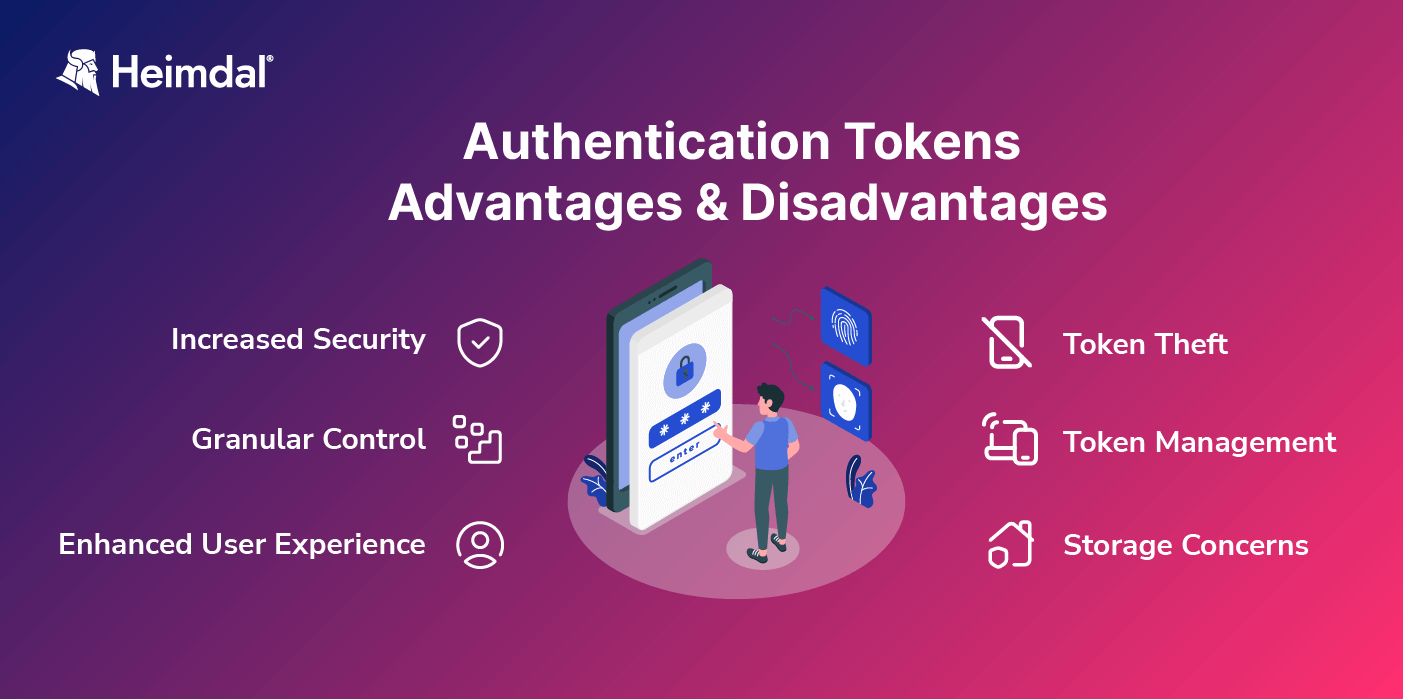Contents:
Secured authentication to databases and systems is essential to enterprise cybersecurity management. According to the 2023 Data Breach Investigations Report, 82% of all breaches stem from human error, often due to mishandled or compromised login details that allow malicious entities unauthorized access to network resources.
Fortunately, there’s an approach that guarantees security without the vulnerabilities inherent in conventional, credential-based methods: token-based authentication.
Token-based authentication is a security protocol that uses a unique, encrypted token to validate users rather than standard credentials such as username and password. Following successful initial authentication, the system generates a token, which is typically made up of encoded data about the user’s identity and session details.
This token is sent to the user and subsequently required for accessing protected resources, ensuring that users don’t have to provide their credentials over and over again. The token often is short-lived and can be used for Single Sign-On (SSO) across different services, reducing potential points of compromise and enhancing the user experience.
The Token-based Authentication Process
The token-based authentication process typically involves the following four steps:
Request
The process starts when a user or system sends an authentication request to the authentication server using their credentials, which are often a username and password. This server is in charge of validating the credentials that were provided.
Credential Verification
The server confirms the submitted credentials by comparing them to a database or user store containing information about authorized users.
Token Generation
Following successful verification, the server generates a token containing relevant data about the user and their access rights. To assure its authenticity and integrity, the server digitally signs this token. The token may also have an expiration timestamp to indicate how long it is valid.
Token Storage
The token is returned to the user’s browser, which keeps it for future website visits. The authentication token is decoded and confirmed when the user navigates to a new website. If there is a match, the user will be able to continue.
Types of Tokens
Most people have encountered a token-based process in some form. Whether it’s entering a one-time code to access an online account, unlocking a mobile device with a fingerprint, or logging into a website via Facebook, these are all familiar examples.
All the authentication tokens grant users access to a device or app. Nevertheless, from software tokens to physical ones, there are various types that can be used to confirm users’ identities. The most common are:
Connected Tokens
Connected tokens are physical devices that are used for authentication. They can be plugged into or connected to a computer or system to add a security layer beyond the traditional username and password. These devices store and generate credentials, which can be used to prove a user’s identity. Smart cards, USB security tokens, and various hardware keys are all examples of connected tokens.
Contactless Tokens
Contactless tokens work by connecting to and communicating with a nearby computer without being physically connected to a server. A good example is a device like a smartwatch or a fitness band, which can use NFC or other wireless means to facilitate payments, access control, or data sharing.
Disconnected Tokens
Disconnected tokens allow users to prove their identity by providing a code that must be manually entered to obtain access to a service. For example, if you use Google Authenticator to generate a time-based one-time password (TOTP) for 2FA (two-factor authentication), this is a type of disconnected token.
Software Tokens
A software token is a digital counterpart to hardware tokens used in two-factor authentication (2FA) and Multi-Factor Authentication (MFA), usually in the form of an app that generates cryptographic values for authentication purposes on devices such as smartphones or computers.
Token-based Authentication vs. OAuth vs. JWT
The authentication process using tokens varies based on the specific token type and protocol in use. Two popular standards are Open Authorization (OAuth) and the JSON Web Token (JWT).
OAuth
OAuth is an open standard authorization framework that allows users to securely share account information with third-party services like Facebook without revealing their credentials.
JWT
This open authentication protocol securely exchanges online data for user authorization. The verification method consists of three elements:
- Header
- Payload
- Signature
Since it uses a rigorous authentication process that can replicate across many applications, JWT is the standard protocol for single sign-on (SSO).
Advantages and Disadvantages of Authentication Tokens

Advantages
Companies that adopt a token-based authentication approach to keep their assets secure reap significant benefits:
Increased Security
Token-based systems can be used as a substitute or addition to traditional password-based approaches, which are significantly more vulnerable when used alone. Tokens are far more secure than passwords because they are self-contained and can only be confirmed by the originating server.
Granular Control
Because token authorization is adaptable, it can be quickly implemented across a wide range of platforms, from apps and databases to servers and sites. System administrators have complete control over token expiration and other contextual specifications.
Enhanced User Experience
Tokens simplify both provisioning and resource access for users and admins. Tokens are simple to generate and scale because no additional hardware or complex configurations are required. Furthermore, they accelerate the authentication procedure, providing users with uninterrupted access until the token expires.
Disadvantages
While token-based authentication has several advantages, organizations should consider the following drawbacks before deploying it.
Token Theft
If a malicious actor obtains authentication tokens, they can impersonate the user without using their credentials. Tokens are similar to keys in that whoever has them has access.
Token Management
Tokens have expiration times, thus systems must manage token renewal and revocation efficiently. As a result, the authentication system may become more complex, particularly if tokens are compromised or leaked.
Storage Concerns
Safe token storage on client-side devices, particularly in web settings, can be challenging. Tokens can be subject to cross-site scripting (XSS) attacks or other security breaches if they are not stored properly.
Token-based Authentication Best Practices
Authentication tokens are intended to improve your security protocols and protect your server. They will, however, be ineffective if your operations are not planned with security in mind. Your authentication tokens should be:
- Private. Users should not share authentication token devices between departments or among themselves. Just as sharing passwords is inadvisable, so is sharing any other part of the security system.
- Safe. HTTPS connections must be used for safe communication between the token and your server. Encryption is an important aspect of keeping tokens secure.
- Tested. Conduct regular token tests to confirm the security and proper functionality of your system. Address any issues promptly if detected.
- Appropriate. Choose the appropriate token type for your specific use case. JWTs, for instance, aren’t great for session tokens. They can be expensive, and the security risks associated with interception are difficult to avoid. Make sure you’re always using the right tool for the job.
Conclusion
Authentication tokens and two-factor authentication play an important role in achieving zero-trust network access control. This method is critical as users increasingly access corporate assets from remote places and due to the growth in unknown devices accessing networks.
Because of the risk of stolen credentials, organizations must establish trust that a user is who they say they are before granting access to their resources. Secure authentication allows companies to identify users who access their networks and block devices or individuals who are not authorized.
It goes without saying that companies need a robust IAM (Identity and Access Management) strategy to ensure the security and proper management of digital identities. By effectively managing user access to sensitive data and systems within their organizations, they can protect against unauthorized access.
Integrate PAM within Your IAM Strategy

Heimdal® Privileged Access Management
- Automate the elevation of admin rights on request;
- Approve or reject escalations with one click;
- Provide a full audit trail into user behavior;
- Automatically de-escalate on infection;
Heimdal comes up with a cutting-edge PAM solution – Privileged Access Management – that helps organizations easily handle user rights while enhancing their endpoint security. As it’s the only tool to auto-deny/de-escalate admin rights on infected machines (if you add the Application Control module into the mix), it substantially increases cybersecurity in your organization.
Token-based Authentication FAQs
What is token-based authentication and how does it differ from traditional authentication methods?
Token-based authentication uses digitally signed tokens to confirm user identity instead of relying on traditional methods like passwords. Once verified, the server generates a token for the user, which they present for subsequent requests. This allows for stateless authentication, where each request from the client to the server contains all the information needed to authenticate the user.
How secure is token-based authentication?
Keep in mind that despite the many benefits of token-based authentication systems, no method is completely foolproof. Tokens on mobile devices, while user-friendly, can be compromised due to device vulnerabilities. Tokens sent via SMS risk interception during transit. Furthermore, if a device is lost or stolen, an attacker is able to gain access to the tokens stored in it.
How are tokens securely stored and transmitted?
Tokens are often kept on the client side using methods such as cookies or local storage and transferred through HTTPS headers. Using short-lived tokens and refresh mechanisms improves security even further.










 Network Security
Network Security
 Vulnerability Management
Vulnerability Management
 Privileged Access Management
Privileged Access Management  Endpoint Security
Endpoint Security
 Threat Hunting
Threat Hunting
 Unified Endpoint Management
Unified Endpoint Management
 Email & Collaboration Security
Email & Collaboration Security








